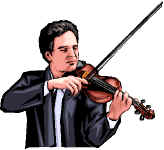


 How do you learn to use vibrato to enhance your playing?
This is a difficult
question to give a direct answer to, using vibrato to play expressively.
Though it is relatively easy to learn to play with vibrato and control the speed and
amplitude vibrato, it can be a lifelong task to understand how to use it to enhance the
music and the clarify the composer's intention. If you are studying with a teacher, they
can help guide you is using vibrato musically. Even if you are not studying presently,
there are some basic guidelines you can follow which can help you develop your
musicianship and understanding.
How do you learn to use vibrato to enhance your playing?
This is a difficult
question to give a direct answer to, using vibrato to play expressively.
Though it is relatively easy to learn to play with vibrato and control the speed and
amplitude vibrato, it can be a lifelong task to understand how to use it to enhance the
music and the clarify the composer's intention. If you are studying with a teacher, they
can help guide you is using vibrato musically. Even if you are not studying presently,
there are some basic guidelines you can follow which can help you develop your
musicianship and understanding.
- Listen to lots of soloists--flutists, string players and singers. Pay careful attention to how much, where and when these artists use vibrato. There is no better teacher than your own thoughtful and analytical listening. If you can hear what someone is doing, chances are you can teach yourself to imitate it.
- It is counterproductive to count the pulses of your vibrato when you are playing after you have learned to control the speed. Doing it this way is too cold, analytical and scientific. Using vibrato has to do with warmth, emotion and life itself. Think instead of the emotional content of the music. Passionate music demands a fast, deep vibrato. On the other hand, mysterious music might use a very shallow, quick vibrato. Something that is more lyrical might require a slower, shallow vibrato.
- Know the rules of musical syntax. Music is a
language just as English, French and Chinese are. Each language has rules for word order
(phrasing in music). For starters, there are strong beats and weak beats in a measure with
the first beat alway s the strongest unless displaced by an accent. The basic musical
impulse is to move from weak to strong beats regardless of the nota
 tion. Bar lines look
like stop signs but are actually green lights. Go from the last beat of the measure to the
first beat. (This is similar to how string players play an upbeat with an upbow--a weaker
stroke--and a strong beat with a downbow--a stronger stroke). You would not use vibrato on
a weak beat because it draws undue attention to it. Use vibrato to help show the strong
beats. Your audience does not have the benefit of seeing the music so you have to show
them by how you play what is on the page. The more clearly you speak the language, the
more effective your performance.
tion. Bar lines look
like stop signs but are actually green lights. Go from the last beat of the measure to the
first beat. (This is similar to how string players play an upbeat with an upbow--a weaker
stroke--and a strong beat with a downbow--a stronger stroke). You would not use vibrato on
a weak beat because it draws undue attention to it. Use vibrato to help show the strong
beats. Your audience does not have the benefit of seeing the music so you have to show
them by how you play what is on the page. The more clearly you speak the language, the
more effective your performance. - Vibrato is unnecessary in rapid passage work. It sounds fussy and affected. Above all, remember to use vibrato to enhance the phrase. Vibrato is not a switch on an electric organ to turn on and use indiscriminately.
Above all, have fun as you learn to incorporate vibrato into your playing. Vibrato adds color, vitality and interest to your playing, both for you and for your audience. Practice well!